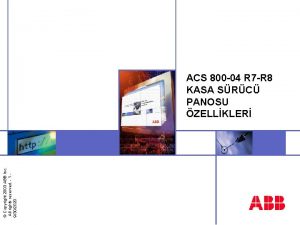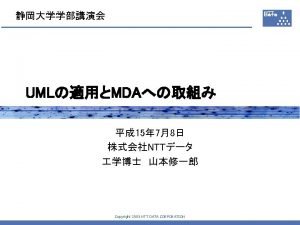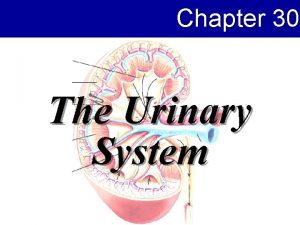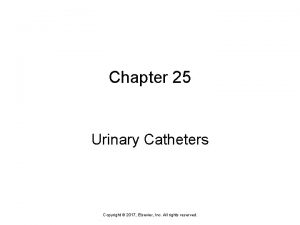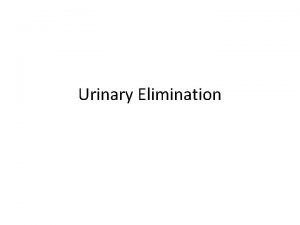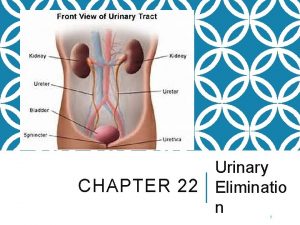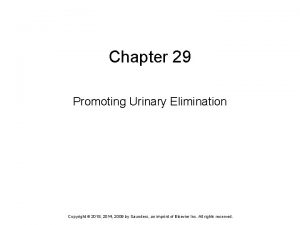Chapter 22 Urinary Elimination Copyright 2011 2007 2003


















- Slides: 18

Chapter 22 Urinary Elimination Copyright © 2011, 2007, 2003, 1999 by Mosby, Inc. , an affiliate of Elsevier Inc.

The urinary system: Removes waste products from the blood Ø Maintains the body’s water balance Ø Copyright © 2011, 2007, 2003, 1999 by Mosby, Inc. , an affiliate of Elsevier Inc. Slide 2

Normal Urination The healthy adult produces about 1500 ml (milliliters) or 3 pints of urine a day. Factors affecting urine production include: Ø Ø Ø Age Disease Amount and kinds of fluid ingested Dietary salt Body temperature and perspiration Drugs Frequency of urination is affected by: The amount of fluid intake, habits, and available toilet facilities Ø Activity, work, and illness Ø Copyright © 2011, 2007, 2003, 1999 by Mosby, Inc. , an affiliate of Elsevier Inc. Slide 3

The person’s elimination needs are assessed. Ø A care plan is developed to ensure that these needs are met. Normal urine: Is pale yellow, straw-colored, or amber Ø Is clear with no particles Ø Has a faint odor Ø Observe urine for color, clarity, odor, amount, and particles. Bedpans are used by: Persons who cannot be out of bed Ø Women for voiding and bowel movements Ø Men for bowel movements Ø Copyright © 2011, 2007, 2003, 1999 by Mosby, Inc. , an affiliate of Elsevier Inc. Slide 4

Fracture pans are used: By persons with casts Ø By persons in traction Ø By persons with limited back motion Ø After spinal cord injury or surgery Ø After a hip fracture Ø After hip replacement surgery Ø Copyright © 2011, 2007, 2003, 1999 by Mosby, Inc. , an affiliate of Elsevier Inc. Slide 5

Men use urinals to void. Ø Ø Ø The man stands if possible. Some sit on the side of the bed. The man may lie in bed. Some men need support when standing. You may have to place and hold the urinal for some. Persons unable to walk to the bathroom often use commodes. Ø Some commodes are wheeled into bathrooms and placed over toilets. Copyright © 2011, 2007, 2003, 1999 by Mosby, Inc. , an affiliate of Elsevier Inc. Slide 6

Persons unable to walk to the bathroom often use commodes. Ø Ø The commode allows a normal position for elimination. The commode arms and back provide support and help prevent falls. Some commodes are wheeled into bathrooms and placed over toilets; they are useful for persons who need support when sitting. The container is removed if the commode is used with the toilet. Wheels are locked after the commode is positioned over the toilet. Copyright © 2011, 2007, 2003, 1999 by Mosby, Inc. , an affiliate of Elsevier Inc. Slide 7

Urinary Incontinence The basic types of incontinence are: Stress Ø Urge Ø Overflow Ø Functional Ø Reflex Ø Mixed incontinence Ø Transient Ø If incontinence is a new problem, tell the nurse at once. Copyright © 2011, 2007, 2003, 1999 by Mosby, Inc. , an affiliate of Elsevier Inc. Slide 8

The following may be needed: Ø Ø Ø Good skin care and dry garments and linens Promoting normal urinary elimination Bladder training Catheters Incontinence products to help keep the person dry Incontinence is linked to abuse, mistreatment, and neglect. Remember, incontinence is beyond the person’s control. Ø If you find yourself becoming short-tempered and impatient, talk to the nurse at once. Ø The person has the right to be free from abuse, mistreatment, and neglect. Ø Copyright © 2011, 2007, 2003, 1999 by Mosby, Inc. , an affiliate of Elsevier Inc. Slide 9

Persons with dementia may: Void in the wrong places. Ø Remove incontinence products and throw them on the floor or in the toilet. Ø Resist staff efforts to keep them clean and dry. Ø Copyright © 2011, 2007, 2003, 1999 by Mosby, Inc. , an affiliate of Elsevier Inc. Slide 10

Catheters Inserted through the urethra into the bladder, a urinary catheter drains urine into a drainage bag. A straight catheter drains the bladder and then is removed. Ø An indwelling catheter (retention or Foley catheter) is left in the bladder. Ø Catheterization is the process of inserting a catheter. Copyright © 2011, 2007, 2003, 1999 by Mosby, Inc. , an affiliate of Elsevier Inc. Slide 11

Catheters are used: Ø Ø Ø Before, during, and after surgery For people too weak or disabled to use the bedpan, urinal, commode, or toilet To protect wounds and pressure ulcers from contact with urine To allow hourly urinary output measurements As a last resort for incontinence For diagnostic purposes You will care for persons with indwelling catheters. Copyright © 2011, 2007, 2003, 1999 by Mosby, Inc. , an affiliate of Elsevier Inc. Slide 12

Drainage systems Ø A closed drainage system is used for indwelling catheters. • Nothing can enter the system from the catheter to the drainage bag. Some people wear leg bags, which attach to the thigh or calf, when up. Ø The drainage bag is always kept lower than the bladder to prevent urinary tract infections (UTIs). Ø Copyright © 2011, 2007, 2003, 1999 by Mosby, Inc. , an affiliate of Elsevier Inc. Slide 13

If a drainage system is disconnected accidentally: Ø Ø Ø Ø Ø Tell the nurse at once. Do not touch the ends of the catheter or tubing. Practice hand hygiene and put on gloves. Wipe the end of the tube with an antiseptic wipe. Wipe the end of the catheter with another antiseptic wipe. Do not put the ends down. Do not touch the ends after you clean them. Connect the tubing to the catheter. Discard the wipes into a biohazard bag. Remove the gloves and practice hand hygiene. Copyright © 2011, 2007, 2003, 1999 by Mosby, Inc. , an affiliate of Elsevier Inc. Slide 14

Leg bags are changed to drainage bags when the person is in bed. You open the close 4 d drainage system. Ø Prevent microbes from entering the syestem. Drainage bags are emptied and measured: At the end of every shift Ø When changing from a leg bag to a drainage bag Ø When changing from a drainage to a leg bag Ø When the bag is becoming full Ø Copyright © 2011, 2007, 2003, 1999 by Mosby, Inc. , an affiliate of Elsevier Inc. Slide 15

To apply condom catheters (external catheters, Texas catheters, urinary sheaths): Follow the manufacturer’s instructions. Ø Thoroughly wash the penis with soap and water. Ø Dry the penis before applying the catheter. Ø Condom catheters are self-adhering or applied with elastic tape. Ø Never use adhesive tape to secure catheters. Ø Copyright © 2011, 2007, 2003, 1999 by Mosby, Inc. , an affiliate of Elsevier Inc. Slide 16

Bladder Training Control of urination is the goal. The person uses the toilet, commode, bedpan, or urinal at certain times. The rules for normal elimination are followed. The normal position for urination is assumed if possible. Privacy is important Four methods: Bladder retraining Ø Prompted voiding Ø Habit training/scheduled voiding Ø Catheter clamping Ø Copyright © 2011, 2007, 2003, 1999 by Mosby, Inc. , an affiliate of Elsevier Inc. Slide 17

Quality of Life Illness, disease, and aging can affect the private act of voiding. Residents often depend on the nursing staff to assist with elimination needs. Promote dignity, comfort, and respect when assisting with elimination needs. You must protect the person’s privacy. Ø If you must stay in the room, allow as much privacy as possible. Empty urinals, bedpans, and commodes promptly. Copyright © 2011, 2007, 2003, 1999 by Mosby, Inc. , an affiliate of Elsevier Inc. Slide 18
 Chapter 22 urinary elimination
Chapter 22 urinary elimination Chapter 24 urinary elimination
Chapter 24 urinary elimination Chapter 22 urinary elimination
Chapter 22 urinary elimination Nur 102
Nur 102 Alteration in urinary elimination
Alteration in urinary elimination Gauss jordan
Gauss jordan Word 2003 to 2007
Word 2003 to 2007 Copyright 2003
Copyright 2003 2008 pearson education inc
2008 pearson education inc Copyright 2003
Copyright 2003 Copyright 2003
Copyright 2003 Copyright 2007
Copyright 2007 Copyright 2007
Copyright 2007 Kidneys location and structure figure 15-1
Kidneys location and structure figure 15-1 Hyperproteinuria definition
Hyperproteinuria definition Chapter 30 the urinary system workbook answers
Chapter 30 the urinary system workbook answers Chapter 15 the urinary system figure 15-3
Chapter 15 the urinary system figure 15-3 Chapter 25 urinary catheters
Chapter 25 urinary catheters Chapter 20 urinary/excretory system
Chapter 20 urinary/excretory system







